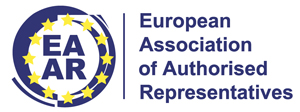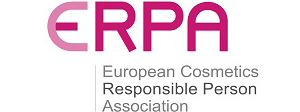Dear Colleagues,
It is our pleasure to invite you to join us at The Virtual 5th ERPA Annual Congress on Regulations and Compliance for Cosmetics which will take place 26-27 January 2021
At a time when digital communication is transforming every industry, every part of our daily life and work, we are committed to run an event that reaches as far as possible and fosters collaboration and engagement among its participants. The Congress will be supported by a special digital platform, allowing everyone to connect, attend, while granting access to the resources provided during the Congress even after its completion.
We look forward to welcoming you online to CRCC2021 – The Virtual 5th ERPA Annual Congress on Regulations and Compliance for Cosmetics.

Gideon Elkayam
Obelis
CRCC2021 Congress Chair
Congress Program

European Commission, Belgium
– What are the topics the European Commission is focusing on at the moment?
– What other topics are expected in the near future?
– What is Covid-19 impact from the Commission perspective and at the Commission level?

Vrije Universiteit Brussels, Belgium
Prof Em. Vera Rogiers
In Vitro Toxicology and Dermato-Cosmetology (IVTD), Vrije Universiteit Brussel
Corona viruses usually infect humans via mouth, nose or eyes by introducing their genetic material in the cells of contact. Virus particles on the hands cannot penetrate trough intact skin, but infection by the hands may occur by touching face and eyes. It is therefore important to effectively destroy, as soon as possible, all virus particles on hands and objects that are regularly touched. This can be done with detergent solutions. The structure and composition of the viral particles play an important role in choosing the active ingredients that are capable of de-risking potential contacts. The question is what are these trustable ingredients? As well soaps as syndets may be used, but most people do not make the difference between both groups of substances. Therefore, the use of tensioactive substances will be discussed making a clear difference between soaps and syndets by providing positive and negative effects of both categories. Also, some relevant examples will be given. When washing hands with tensioactive substances is not possible, disinfection is carried out by using alcoholic solutions. Here too, not all preparations are active against viruses and their performance highly depends on the vol % of the alcohol present. Furthermore, disinfectants that have been tested for their killing effect on bacteria, are not necessarily effective against viruses. Finally, hand creams may play a role in keeping a healthy skin when months of washing hands and disinfection are daily reality.

Spanish Agency of Medicines and Medical Devices (AEMPS), Spain

Spanish Agency of Medicines and Medical Devices (AEMPS), Spain
Over the last few years the Spanish Agency of Medicines and Medical Devices (AEMPS) Cosmetic Unit, has noticed a proliferation of “Zero waste” philosophy shops. In them, cosmetic products can be packaged at the purchaser´s request.
Spanish authorities have concerns on how this activity is being performed by the shops. We are also worried about the information that the customers receive during the sale and on the label of the products.
During 2019 AEMPS developed a Cosmetic Product Market Surveillance Campaign to check the situation, and many infringements were detected.
As a result of this Campaign, AEMPS is preparing a document to help all the implicated agents to develop this activity in the best conditions of quality and safety.
We would like to show some key points of the document in this forum.

The Regulatory Company, Netherlands
– Special focus lately on cosmetics vs. biocides?
– Are there court cases because of wrong classification?
– If a product is “multi-tasking” falling under more regulatory frameworks, what do you do?

MDSS, Germany
- Regulatory requirements for cosmetic claims
- Types of claims
- How to prove claims

Inovapotek, Portugal
- How to proof a cosmetic claim?
- in vivo or in vitro or ex vivo studies?
- Are tests performed on ingredients enough?
- Is a consumer test enough to proof my claim?
- Good Clinical Practices (GCP) or Good Laboratorial Practices (GLP)? Which Ones are Applicable to Cosmetic Product Testing?

The International Natural and Organic Cosmetics Association - NATRUE, Belgium
The European cosmetics industry is tightly-regulated via a harmonised set of regulations. Whilst product claims are regulated, and must not be misleading, there is no official definition or harmonised criteria in the EU to substantiate precisely how green claims like ‘natural’ or ‘organic’ are applied to a cosmetic product without being misleading. As Europe transitions to a green and sustainable future, inevitability there is an increasing demand for greater transparency throughout the value chain. NATRUE will outline the existing regulatory framework, new initiatives under development, voluntary label schemes, and other tools available to help orientate cosmetic producers and consumer alike.

Qacs Laboratories, Greece

Intertek, India

University of Genoa, Italy
Endocrine disruptors (EDs) are xenobiotics able to alter endocrine system homeostasis causing adverse health effects in an intact organism, or its progeny, or (sub)populations. Humans are frequently exposed to one or to a mixture of ED by inhalation, ingestion, and/or dermal contact of several products. Some suspected ED in cosmetics are under the EU lens, because they could increase the source of endocrine disruption in humans. EDs can be included in a cosmetic product as active principles, as a contaminant or as a by-product leached form packaging.
The ED mode of action does not fit to classical linear toxicology trend but shows non-linear trend and it can occurs at several levels of hormone homeostasis: firstly, influencing hormone’s binding to its specific receptor, but also by modifying hormone regulation, synthesis, secretion, transport and degradation. The uniqueness of EDs among all categories of xenobiotic substances imply a brand new strategy for assessing their effect on products used daily by humans. A case by case strategy for assessing safety of ED in cosmetics suggested by Prof. Vera Rogiers (SCCS Co-chair) is in line with ED action. In this scenario, some tests should be mandatory and included in the safety evaluation of all ED compounds in cosmetics.
The possible presence of ED in cosmetics opens a new branch of studies on human exposure, usually not included in classical toxicology, but more related to endocrinology. Therefore, a new role for experts in this field should be considered when evaluating safety of ED in cosmetics.

QACS Laboratories, Greece
– Status of the impact assessment on fragrance allergens labelling
– Implications
– Implementation

European Commission, Belgium
During these challenging times, the resilience and adaptability of the European Cosmetics sector is a perfect example of an industrial sector resisting, while contributing to society’s wellbeing and even health protection against COVID-19. In spite of the pandemic, a number of activities have been initiated, are progressing or have been concluded in the cosmetics sector. In this presentation, the Commission services have outlined in a short, yet comprehensive way, all activities within the cosmetics sector related to three main topics: (i) Substances with endocrine disrupting properties, (ii) nanomaterials and (iii) the “Chemicals Strategy for Sustainability” as part of the Commission’s Green Deal. For each of these topics, an overview of the Commission activities is presented, together with follow-up proposals and future actions.

Bloom Regulatory, UK

EXPERTOX, France
– Overview of the compliance process – what does it imply?
– Why it is crucial to be first compliant?
– RAPEX
– SUE / UE
– keeping your PIF, including SA report, updated periodically
To be compliant on the process before sales need a couple of measures that to be anticipated. First, to be compliant it means to contribute to consumer safety and to the protection of their health. The good understanding of the respective roles and responsibilities of each person involved on the sales chain ensures compliance with the Cosmetics Regulation. The setting of an information system: PIF (product information file) and safety assessment report are the required steps, not only before to place on the market but also during all the time market. This follow-up establishes an organized system for the exchange of information concerning products that may affect the health and the safety of consumers by means RAPEX : Rapid Alert System for dangerous non-food products is the EU rapid alert system notifying member states about risks to the health and safety of consumers.

EXPERTOX, France
– Overview of 22716 requirements
– Highlights on how important is to be GMP certified
The Cosmetics Regulation (EC) 1223/2009 requires that all cosmetic products placed on the European market comply with Good Manufacturing Practices (GMP) set by the ISO 22716 standard. This standard covers the quality aspects of the product. It gives guidelines for the production, control, storage and shipment of cosmetic products. GMP concern all those involved in the manufacture, such as: raw materials providers, finished product manufacturers, distributors, importers / exporters. It’s important to note that ISO 22716 does not cover aspects of protection of the environment. This presentation presents the goal of GMP for cosmetic products (e.g. : prevent contamination, prevent mix ups and errors, establish process controls,…) and how set up a couple of measures that have to be implemented in relation to the manufacturing process, control, storage and shipment. Also, the following questions: how GMP affect product processing and how make audit of the quality systems ? are discussed.

EXPERTOX, France
– type of cosmetic cases reaching the court
– What happens then and there?
– how is the court interpreting the cosmetics regulation 1223/2009/EC
As any industrial product, cosmetic products are sometimes subject to legal expertise, always with the objectives to assure the protection of the consumer and to protect their health. Expertise cases are subject of various investigations lead by judicial experts and under the direction of an investigating judge. Identification of counterfeits, search for unauthorized substances, investigation of non – compliant labeling, misleading product, are all cases that can be submitted to expertise…

Angel Consulting, Italy
– What is the status?

Obelis, Belgium
Sponsors & Exhibitors

Contact Us
We look forward to hearing from you.









